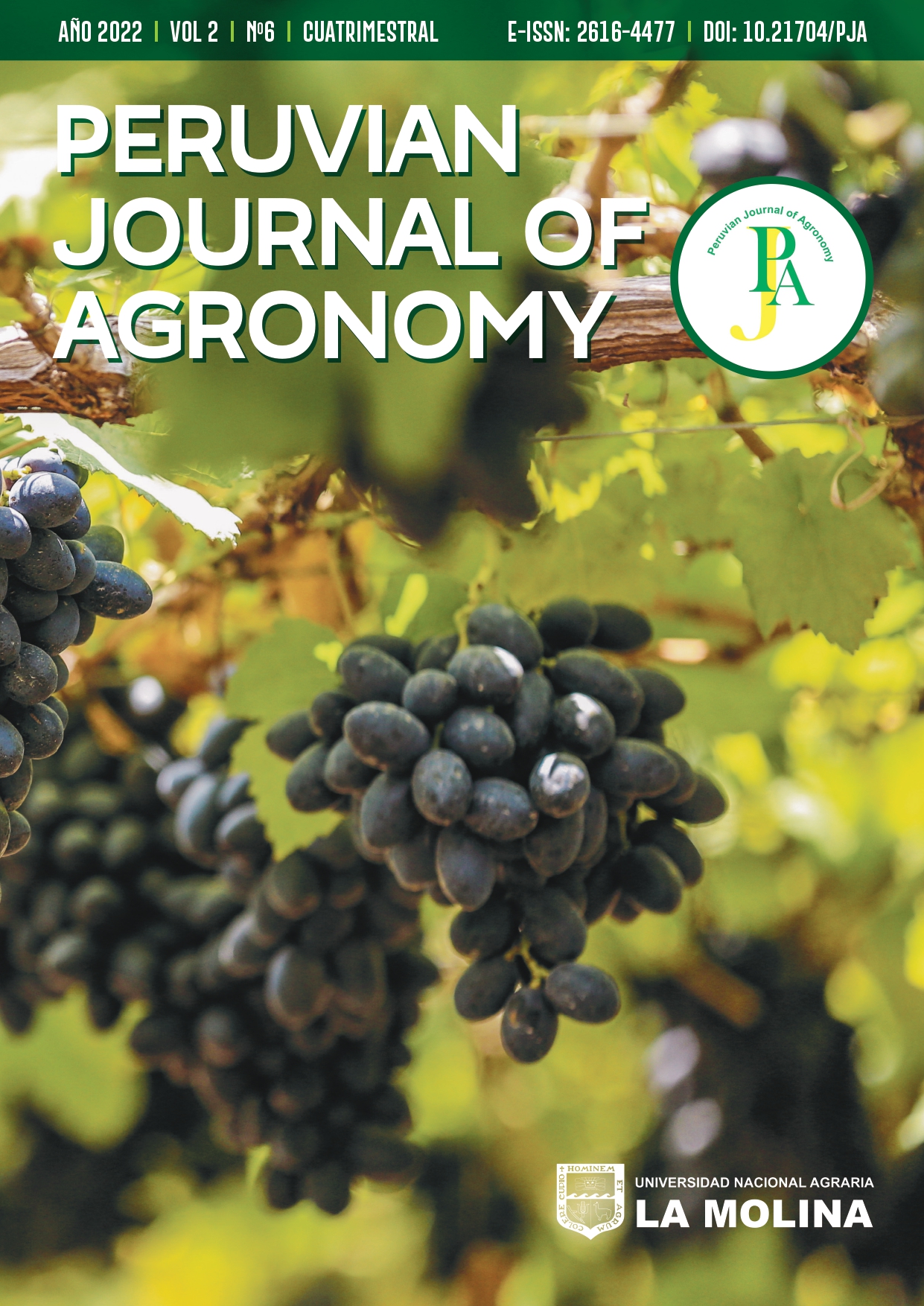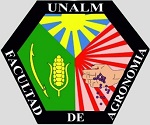Identification of bread wheat genotypes (Triticum aestivum L.) with tolerance to drought conditions at the central coast of Peru
DOI:
https://doi.org/10.21704/pja.v6i2.1964Keywords:
Bread wheat, drought, tolerance index, genotypesAbstract
Wheat is sown mostly in Peru, in areas above 3000 m altitude, under rainfed conditions and frequent drought problems during the crop cycle. It is a cereal used as a staple food by the families of small-scale farmers who are dedicated to their cultivation, which is why it is necessary to develop varieties with drought tolerance. This investigation had as objectives (1) to determine the yield potential of wheat genotypes under drought stress conditions, (2) to determine the susceptibility indices and drought tolerance, and (3) to identify drought tolerant genotypes. Nine genotypes introduced from CIMMYT and the commercial variety “Centenario” wheat flour (Triticum aestivum L.) were studied in an environment with complete irrigation during the life cycle and another environment with terminal drought stress or deficit irrigation applied in the boot phase (Z4.0). A Random Complete Blocks design was used with three repetitions. Agronomic characteristics, quality evaluations were carried out following the established protocols for each characteristic evaluated and the stress tolerance indices (STI), mean productivity (MP), geometric mean productivity (GMP), tolerance index (TOL), and stress susceptibility index (SSI), were determined. The reduction in the grain yield varied from 17.95 % to 33.27 % mainly due to drought. The SSI ranged from 0.65 (G-3) to 1.21 (G-6 y G-9), meanwhile the TOL ranged from 1 316.8 (G-3) to 3 142.68 (G-7). The MP, STI and GMP indexes allowed the identification of genotypes with the greatest tolerance to irrigation and stress conditions of the 5 genotypes: G- 1, G-2, G-7, G-8 and G- 10. These results are important for developing new varieties that adapt to drought conditions and to face climate change in the Andean region.
Downloads
References
Abayomi, Y. A., & Wright, D. (1999). Effects of water stress on growth and yield of spring wheat (Triticum aestivum L.) cultivars. Tropical Agriculture (Trinidad and Tobago), 76(2), 120–125.
Abid, M., Tian, Z., Ata-Ul-Karim, S. T., Cui, Y., Lui, Y., Zahoor, R., Jiang, D., & Dai, T. (2016). Nitrogen nutrition improves the potential of wheat (Triticum aestivum L.) to alleviate the effects of drought stress during vegetative growth periods. Front Plant Sci 7(981). https://doi.org/10.3389/fpls.2016.00981
Aktas, H. (2016). Drought tolerance indices of selected landraces and bread wheat (Triticum aestivum L.) genotypes derived from synthetic wheat. Applied Ecology and Environmental Research, 14(4), 177–189. http://www.aloki.hu/pdf/1404_177189.pdf
Amado, A. G. (2016). Efecto del déficit hídrico moderado en la fase fenológica del espigado y madurez de grano en 15 líneas avanzadas de Triticum Aestivum L. “Trigo Harinero”, la Molina, Lima – Perú. [Bachelor’s thesis, Universidad Nacional San Agustin] Institutional repository. http://repositorio.unsa.edu.pe/handle/UNSA/1822
Askary, M., Maghsoudi, A., Saffari, V., Askari, A. (2018). Effects of drought stree on some physiological variables and grain yield of different wheat varieties. Journal of Plant Physiology and Breeding, 8(1), 57–73.
Ayed, S., Rezgui, M., Othmani, A., Rezgui, M., Trad, H., Texeira-da Silva, J., Ben M., Ben, H., & Kharrat, M. (2017). Response of Tunisian durum (Triticum turgidum ssp. durum) and bread (Triticum aestivum L.) wheats to water stress. agrociencia, 51(1), 13–26.
Bauder. J. (2001). Irrigation with Limited Water Supplies. Montana State University, Communications Services. Montana Hall. Bozeman, MT 59717. USA. http://region8water.colostate.edu/PDFs/Irrigating%20with%20Limited%20Water%20Supplies.pdf
Bidinger, F., Mahalakshimi, V., & Rao, G. (1987). Assessment of drought resistance in pearl millet (Pennisetum americanum L. Leeke) I factor affectingyields understress. Australian Journal Agricultural Research, 38, 37–48.
Blum A. (2005). Drought resistance, wateruse efficien , and yield potential—Are they compatible, dissonant, or mutually exclusive?. Australian Journal of Agricultural Research, 56(11), 1159–1168. https://doi.org/10.1071/AR05069
Ceccarelli, S., & Grando S. (1991). Selection environment and environmental sensitivity in barley. Euphytica, 57, 157–167. https://doi.org/10.1007/BF00023074
Eid, M. H., & Sabry, S. (2019). Assessment of Variability for Drought Tolerance Indices in Some Wheat (Triticum aestivum L.). Genotypes. Egypt. J. Agron. 41(2), 79–91. https://doi.org/10.21608/AGRO.2019.10401.1153
Fernández, G. C. J. (1992). Effective selection criteria for assessing plant stress tolerance. In: C. G. Kuo (Ed.), Proceedings of the International Symposium on Adaptation of Vegetables and Other Food Crops in Temperature and Water Stress, Publication, Tainan, Taiwan, 257–270 https://doi.org/10.22001/wvc.72511
Fischer, R. A. & Maurer, R. (1978). Drought resistance in spring wheat cultivars: I. Grain yield response. Australian Journal of Agricultural Research 29(5) 897–912. https://doi.org/10.1071/AR9780897
Gallagher, J. N., Biscoe, P.V., & Hunter, B. (1976) Effects of drought on grain growth. Nature, 264, 541–542. https://doi.org/10. 1038/264541a0
Golabadi, M., Arzani, A., & Maibody, M. (2006). Assessment of drought tolerance in segregation population in durum wheat. African Journal of Agricultural Research, 1(5), 162–171. https://www.researchgate.net/publication/228787570_Assessment_of_drought_tolerance_in_segregating_Populations_in_durum_wheat
Kiliç, H. & Yağbasanlar, T. (2010). The effect of drought stress on grain yield, yield components and some quality traits of durum wheat (Triticum turgidum ssp. durum) Cultivars. Not. Bot. Hort. Agrobot. Cluj, 38 (1), 164–170. https://doi.org/10.15835/nbha3814274
Khan, M., Shabbir, G., Akram, Z., Shah, Ansar, M. M., Cheema, N. M., & Iqbal, M. (2013). Character association studies of seedling traits in different wheat genotypes under moisture stress conditions. SABRAO journal of breeding and genetics, 45(3), 458–467. https://www.researchgate.net/publication/263001737_Character_association_studies_of_seedling_traits_in_different_wheat_genotypes_under_moisture_stress_conditions
Khayatnezhad, M., Zaeifizadeh,M., & Gholamin, R. (2010). Investigation and selection index for drought stress. Australian Journal of Basic and Applied Sciences, 4(10), 4815–4822.
Khayatnezhad, M., & Gholamin, R. 2018. The new formula is proposed for drought resistance for seed selection on Breeding program (DSTI). Sci. Agri. 21 (2), 2018: 73-76.
Khodarahmpour, Z., Choukan, R., Bihamta, M. R., & Hervan, E. M. (2011). Determination of the best heat stress tolerance indices in maize (Zea mays L.) inbred lines and hybrids under Khuzestan Province conditions. Journal of Agricultural Science and Technology 13, 111–121. http://jast.modares.ac.ir/article-23-6969-en.html
Manes, Y., Gomez, H., PuhL, L., Reynolds, M., Braun, H., Trethowan, R. (2012). Genetic yield gains of the CIMMYT international semi-arid wheat yield trials from 1994 to 2010. Crop Science, 52, 1543–1552. https://doi.org/10.2135/cropsci2011.10.0574
Mohammadi, R. (2019). The use of a combination scoring index to improve durum productivity under drought stress. Experimental Agriculture, 56(2), 161-170 https://doi.org/10.1017/S0014479719000231
Mohammadi, M., Karimizadeh, R., & Abdipour, M. (2011). Evaluation of drought tolerance in bread wheat genotypes under dryland and supplemental irrigation conditions. Australian Journal of Crop Science, 5(4), 487-493
Mwadzingeni, L., Shimelis, H., Dube, E., Laing, M. D., & Tsilo T. J. (2016). Breeding wheat for drought tolerance: Progress and technologies. Journal of Integrative Agriculture, 15(5), 935–943. https://doi.org/10.1016/S2095-3119(15)61102-9
Patel, J. M., Patel, A. S., Patel, C. R., Pansuria, A. G., Patel, R. M. & Vanapariya, L. G. (2017). Evaluation of selection indices for drought tolerance in some bread wheat genotypes. Electronic Journal of Plant Breeding, 8(3), 834–841. https://doi.org/10.5958/0975-928X.2017.00133.8
Patel, J. M., Patel, A. S., Patel, C. R., Mamrutha, H. M., Pradeep, S., & Pachchigar, K. P. (2019). Evaluation of Selection Indices in Screening Durum Wheat Genotypes Combining Drought Tolerance and High Yield Potential. International Journal of Current Microbiology and Applied Sciences, 8(4), 1165–1178, ISSN: 2319–7706 https://doi.org/10.20546/ijcmas.2019.804.134
Pourdad, S. S. (2008). Study of drought resistance indices in spring safflow . Acta Agronomica Hungarica, 56(2), 203–212. https://doi.org/10.1556/AAgr.56.2008.2.9
Rivero, R. M., Kojima, M., Gepstein, A., Sakakibara, H., Mittler, R., Gepstein, S., & Blumwald, E. (2007). Delayed leaf senescence induces extreme drought tolerance in a flowering plant. Proc Natl Acad Sci, 104(49), 19631–19636. https://doi.org/10.1073/pnas.0709453104
Rosielle, A. A., & Hamblin, J. (1981). Theoretical aspects of selection for yield in stress and non-stress environment. Crop Sci., 21, 943–946. https://doi.org/10.2135/cropsci1981.0011183X002100060033x
Sallam, A., Hashad, M., Hamed, E-S., & Omara, M. (2015). Genetic variation of stem characters in wheat and their relation to kernel weight under drought and heat stresses. Journal of Crop Science and Biotechnology, 18, 137–146 https://doi.org/10.1007/s12892-015-0014-z
Sallam, A., Mourad, A. M. I., Hussain, W., & Baenziger, P. S. (2018). Genetic variation in drought tolerance at seedling stage and grain yield in low rainfall environments in wheat (Triticum aestivum L.). Euphytica 214, 169. https://doi.org/10.1007/s10681-018-2245-9
Sareen, S., Tyagi, B. S., & Sharma, I. (2012). Response estimation of wheat synthetic lines to terminal heat stress using stress indices. Journal of Agricultural Science, 4(10), http://dx.doi.org/10.5539/jas. v4n10p97
Talebi, R., Fayaz, F. & Naji, A. M. (2009). Effective selection criteria for assessing drought stress tolerance in durum wheat (Triticum durum Deft.). General and Applied Plant Physiology, 35, 64–74.
Thiry, A. A., Chavez, P., Reynolds, M. P., & Davies, W. J. (2016). How can we improve crop genotypes to increase stress resilience and productivity in a future climate? A new crop screening method based on productivity and resistance to abiotic stress. Journal of Experimental Botany, 67(19), 5593–5603. https://doi.org/10.1093/jxb/erw330.
Zebarjadi, A., Mirany, T., Kahrizi, D., Ghobadi, M., & Nikoseresht, R. (2012). Assessment of drought tolerance in some bread wheat genotypes using drought resistance indices. Biharean Biologist 6(2), 94–98.
Downloads
Published
Issue
Section
License
Copyright (c) 2022 Gomez-Pando, Ian Dood, Diego Zamudio Ayala, Denisse Deza Montoya, Ana Eguiluz de la Barra

This work is licensed under a Creative Commons Attribution 4.0 International License.







